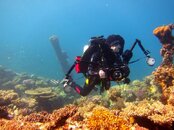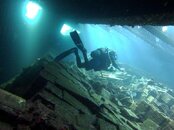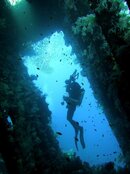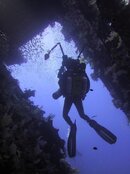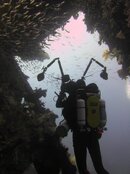You are using an out of date browser. It may not display this or other websites correctly.
You should upgrade or use an alternative browser.
You should upgrade or use an alternative browser.
Please help me pick equipment... (dive computer, regulator, BCDs)
- Thread starter spirula
- Start date
Please register or login
Welcome to ScubaBoard, the world's largest scuba diving community. Registration is not required to read the forums, but we encourage you to join. Joining has its benefits and enables you to participate in the discussions.
Benefits of registering include
- Ability to post and comment on topics and discussions.
- A Free photo gallery to share your dive photos with the world.
- You can make this box go away
Dr. Lecter
Contributor
This is what the marine biologist I was talking about earlier looked like on one of her training dives.
Ugh, what is it with new rEvo divers and
 ty trim? I know (oh how I know) that it's an ass-heavy unit, but it's not that frigging hard to put some lead on the top shelf until you're horizontal again
ty trim? I know (oh how I know) that it's an ass-heavy unit, but it's not that frigging hard to put some lead on the top shelf until you're horizontal again 
Aqua-Andy
Contributor
If this all works out maybe you could create a PADI specialty "How to get someone else to pay for your dive education and equipment". I would be the first one in line!
@aqua-andy: Biologists are constantly looking for new species. The fame and reputation of a research university running a biology department is in great parts made up by its success in finding new species. Donors and sponsors will be happy, more money for more research (research positions, equipment, money for travelling) is likely to come.
Now these schools have realized that in the area below 40 meters and above 120 meters a lot of research regarding new species can be done because nobody has really done it so far. You need qualified scientists who are tech divers at the same time, but you don't need deep-sea submarines, robots or other high-tech equipment that comes with dramatic costs. A day with one of the NOAA submarines will cost a university about US$ 30.000. NOAA Ocean Explorer: Technology: Submersibles: Alvin. In addition to that, the likeliness of finding new species is quite high because you still have a bit of daylight coming through the water. It doesn't matter if you dive in tropical waters or under ice to scratch off little algae structures from icebergs or if you dive in warm or hot spring looking for new sulphur-addicted bacteria.
So why not finding new species without that high daily price in a range between 40 and 120 meters? This is why spirula's school has offered money for diving training and equipment. In my opinion, she should add all costs for basic, advanced, tech and rebreather training, costs for getting experienced in diving, her own gear including tech, photo and rebreather equipment, travelling and lodging costs over a period of at least 2 years and present it to her school. I bet that she will be granted those costs including a free Master or Ph.D. program. This is how it works.
I don't know what your profession is or how far you live away from a research university but a biologist can also never dive alone. Maybe you should jump on the train, get to a biology department and offer your help in such endeavours, especially for the technical part.
Now these schools have realized that in the area below 40 meters and above 120 meters a lot of research regarding new species can be done because nobody has really done it so far. You need qualified scientists who are tech divers at the same time, but you don't need deep-sea submarines, robots or other high-tech equipment that comes with dramatic costs. A day with one of the NOAA submarines will cost a university about US$ 30.000. NOAA Ocean Explorer: Technology: Submersibles: Alvin. In addition to that, the likeliness of finding new species is quite high because you still have a bit of daylight coming through the water. It doesn't matter if you dive in tropical waters or under ice to scratch off little algae structures from icebergs or if you dive in warm or hot spring looking for new sulphur-addicted bacteria.
So why not finding new species without that high daily price in a range between 40 and 120 meters? This is why spirula's school has offered money for diving training and equipment. In my opinion, she should add all costs for basic, advanced, tech and rebreather training, costs for getting experienced in diving, her own gear including tech, photo and rebreather equipment, travelling and lodging costs over a period of at least 2 years and present it to her school. I bet that she will be granted those costs including a free Master or Ph.D. program. This is how it works.
I don't know what your profession is or how far you live away from a research university but a biologist can also never dive alone. Maybe you should jump on the train, get to a biology department and offer your help in such endeavours, especially for the technical part.
Similar threads
- Replies
- 29
- Views
- 3,633
- Replies
- 1
- Views
- 496
- Replies
- 20
- Views
- 1,260
- Replies
- 130
- Views
- 9,444



